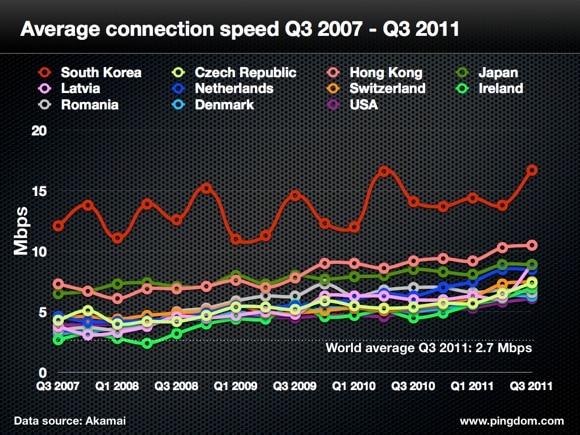Want to be able to download a DVD worth of data in about 38 minutes? It may not seem very impressive, but that’s with the average Internet speed in South Korea, according to the latest “State of the Internet” report by Akamai.
Covering Q3 2011, the report again puts South Korea at the top of the list of countries with the fastest Internet connections. The country scored an average connection speed of 16.7 Mbps in Q3 2011.
Here’s what it looks like for the top 10 countries, with data going back to Q3 2007. Even though the USA on position 13 falls outside the top 10, we decided to include it for comparison.

The global average connection speed continued to increase in the third quarter of 2011, climbing 4.5% to 2.7 Mbps. If you look at the chart above, you can see that, over the entire period from Q3 2007, all countries enjoyed increasing speeds. Also, all countries have seen average speeds jump up and down between quarters, although the effect is much more noticeable for South Korea.
Overall, Akamai reported that the worldwide average connection speed increased in Q3, up 4.5% to 2.7 Mbps. South Korea saw a growth of over 10% in the quarter. Many other countries also enjoyed a growth during the quarter, including Hong Kong, Japan, Latvia, Switzerland, and the USA.
In total, Akamai noticed increased average speeds for 86 countries, and a decline for 47 countries. Out of the top 10 countries, only Romania saw a decline in the most recent quarter.
We know what you’re thinking, that South Korea rules the average connection speed, but some other country is faster in terms of top speed. We’re sorry to disappoint you, but even in peak connections, South Korea rules, with 46.8 Mbps.
An Internet user’s dream
It would seem like South Korea is somewhat of an Internet user’s dream. The country also enjoys a very high Internet penetration. According to the latest World Bank figures from 2010, 82.5% of South Koreans are online, ranking the country in 11th place worldwide.
We will continue to monitor Internet connection speeds around the world using Akamai and other sources. Will South Korea continue to be number one? We’ll see.



























